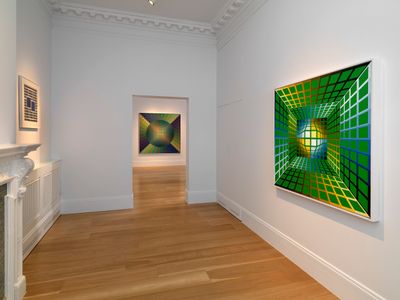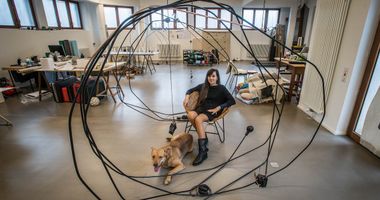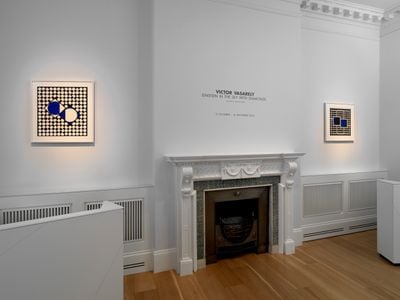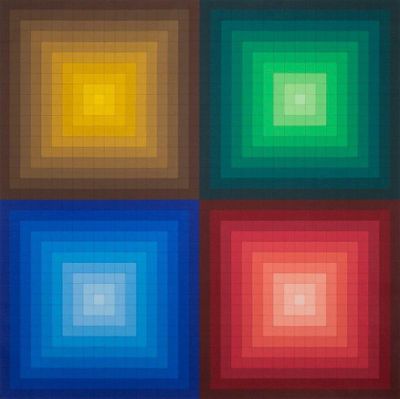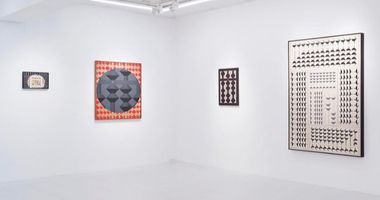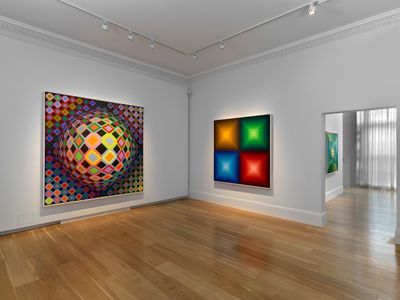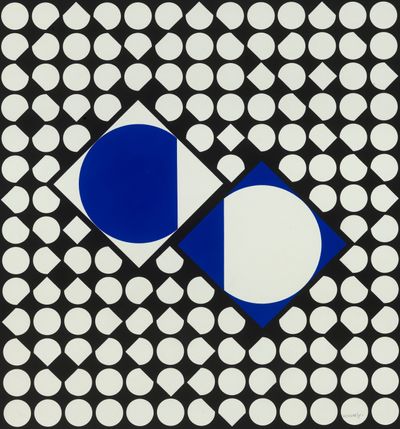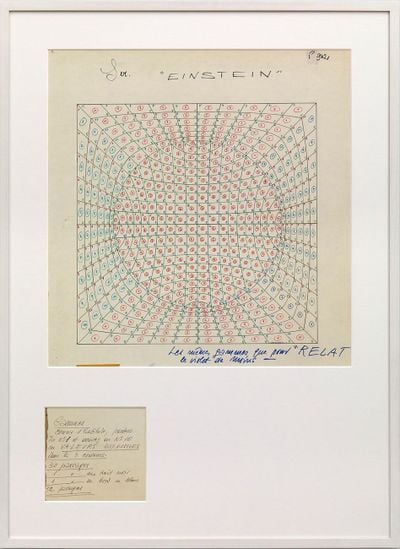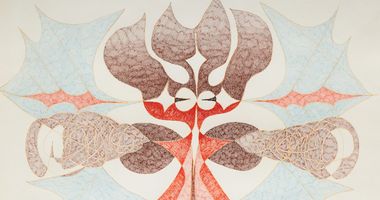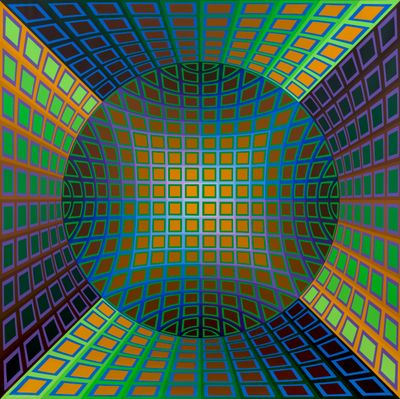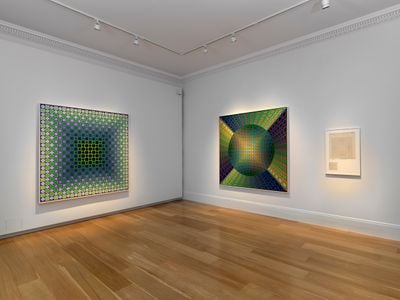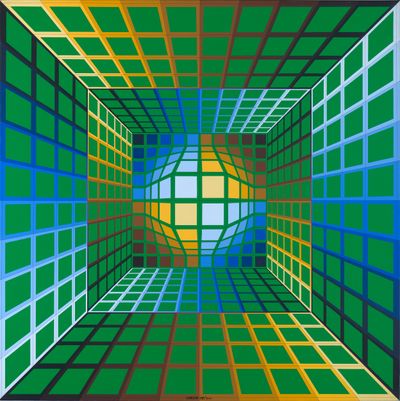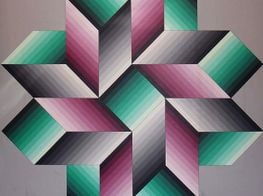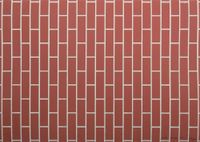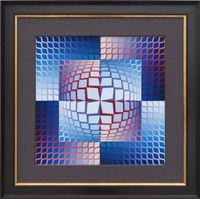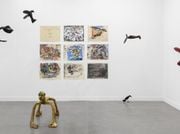Victor Vasarely's Kaleidoscopic Abstractions
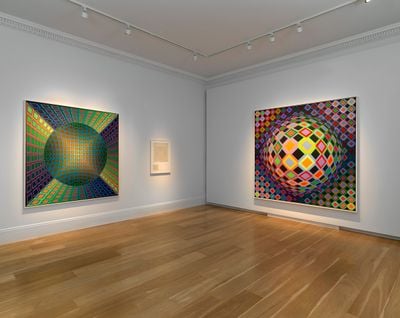
Left to right: Victor Vasarely, Einstein-Ker (1976); Einstein (1976); Vega-Multi (1976). Exhibition view: Einstein in the Sky with Diamonds, Mazzoleni, London (12 October–16 December 2022). Courtesy Mazzoleni, London/Turin. Photo: Todd-White Art Photography.
For the greater part of his life, Hungarian painter Victor Vasarely sought to represent the building blocks of the universe. The artist's geometric abstractions merged principles in art and design to visualise the world as uncovered by leading scientific theories of his time.
Among these hypotheses are Albert Einstein's theory of relativity, Werner Heisenberg's quantum theory, which focused on observable matter, and Niels Bohr's atomic model for quantum physics—all of which Vasarely read as a student of medicine in Budapest in 1925.
But while science offered suggestions, Vasarely found its models of the world limited. Seeking a more expansive language, the Pécs-born artist would turn to art, enrolling at the Podolini-Volkmann Academy in Budapest in 1927 to study traditional painting.
The same year, Vasarely made his first advertising works, which foreshadowed his studies at the Mühely Academy in Budapest, where the curriculum modelled after the Bauhaus school centred on graphic art and typographic design. Enrolling from 1929 to 1930, Vasarely was introduced to abstraction and geometry, eventually locating the basis of his compositions: the cube.
After graduation, Vasarely moved to Paris, where he worked as a poster artist and a consultant for advertising firms. Organic lines and patterns from his graphic design translated to paintings like Zebra (1937). Among the earliest examples of Op Art, a pair of zebras constructed from curving white stripes appear merge as their forms intersect over a black ground.
Following a period of figuration, the artist turned to abstraction in the 1940s, influenced by the likes of Piet Mondrian. Acrylic paintings on canvas like Arc Tur (1968)—a square divided into gradated grids of yellow, green, red, and blue—reflect the idea of abstracting nature into an arrangement of basic colours and shapes to capture its so-called essence.
The painter's visual language would be officialised during a stay in Belle Île, France in 1947, where Vasarely reported noticing the 'internal geometry of nature' while promenading along the Breton shores, after which geometric shapes became the sole basis of his work.
To further systematise his process, Vasarely would conceive a 'plastic alphabet' that would allow him to standardise his compositions, as though a computer program. Arranged within dense grids, simple shapes like diamonds, circles, and squares denote fundamental particles of the universe like atoms and molecules.
Resulting paintings like Vega-Multi (1976) captivate. Modelled after one of the brightest stars in the galaxy, a large sphere protrudes from the centre of the canvas, emerging from a grid of smaller diamond shapes with recurring purples, yellows, oranges, and pinks.
Among Vasarely's later works, Vega-Multi stands out within the constellation of seven paintings and one blueprint at Mazzoleni in London, where four decades of the artist's practice are on display in the exhibition Einstein in the Sky with Diamonds (12 October–16 December 2022).
Earlier works from 1957 include Cassiopée 3 and Bellatrix 3—geometric grids mostly devoid of colour and three-dimensional forms. In the former, two circular halves representing the star in question are entrapped and segregated by squares. Wrapped inside a black-and-white grid evoking matter and anti-matter, they face one another, as if caught in parallel universes.
For the greater part of his life, Victor Vasarely sought to represent the building blocks of the universe.
Vasarely would later introduce colour and depth to his compositions using preparatory sketches. These 'programmations' distributed tones and shades within individual units to generate the impressions of movement and distortion that would characterise Op Art.
One such blueprint conceived on cardboard is on view at Mazzoleni, detailing the composition of Einstein-Ker (1976) on its left. Succeeding numbers from one to ten mark columns and rows ordering hundreds of geometric units, reflecting the colour that would go inside and along the borders of each.
Among later works, Einstein-Ker appears to visually articulate Einstein's theory of relativity. Gridded columns branch out from a warped central globe, spanning a spectrum of bright oranges to dark purples, mirroring the distortion created by large objects within time-space.
These principles for a universal design would be articulated in 'The Yellow Manifesto' in 1955. Co-written with Pontus Hulten and Roger Bordier, the text was shared as part of Le Mouvement—an exhibition at Galerie Denise René in Paris, reputed to have cemented the Kinetic art movement, with works by seminal figures like Alexander Calder and Yaacov Agam.
Structured after 15 core shapes and their variations, the 'Alphabet Plastique' series (1960–1965) later materialised these principles by introducing a formal language that could be understood by all audiences, regardless of education or shared references.
True to the modernist spirit, Vasarely created many series over the years, including the 'Vega' paintings (1950s–1980s), which distorted simple checkered grids. The latter advanced a 'kinetic visual' that focused on the viewing experience, reflecting perceptual shifts introduced by the onset of digital mediums and aerospace.
Made the following decade, 'Planetary Folklore' (1960s) visualised Vasarely's universal language of forms with coloured grids, while the later 'Gestalt' paintings (1969) feature hexagonal prisms that recall M.C. Escher's architectural illusions.
Mirroring the infinities of space and the corresponding possibilities within a flat surface is Dorlak (1991). At the far end of an open cube, a small, prismatic shape protrudes, surrounded by layers of gold and blue-toned grids against an emerald ground.
Attesting to the growing complexity of Vasarely's compositions, the eye takes in the co-existence of multiple dimensions on the same plane. Here, the painting appears almost as a digital illustration, evoking the onset of a data-driven universe. —[O]

